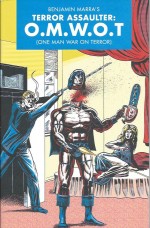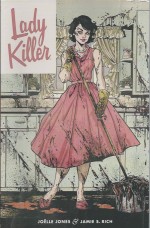
By Stephen Murphy & Michael Zulli with Alan Moore and an Introduction by Dave Sim and Afterword by Stephen R. Bissette (Dover Comics & Graphic Novels)
ISBN: 978-0-846-79813-4
Win’s Christmas Gift Recommendation: Epic, Enthralling, Exciting… 10/10
During the 1980s the American comics scene experienced an astounding proliferation of new titles and companies following the birth of the Direct Sales Market. With publishers now able to firm-sale straight to specialised, dedicated-retail outlets rather than overprint and accept returned copies from general magazine vendors, the industry was able to risk and support less generic titles whilst authors, artists and publishers could experiment without losing their shirts.
The huge outpouring of fresh material deriving from the Direct Sales revolution resulted in a plethora of innovative titles and creators – and let’s be honest – a host of appalling, derivative, knocked-off, banged-out trash too. Happily I’m the boss of me and I choose to focus on the great stuff…
The period was an immensely fertile time for English-language comics-creators. Comics shops – run by people in touch with their customers and who actually read and loved at least some of what they sold – sprang up everywhere and host of new publishers began to experiment with format, genre and content, whilst eager readers celebrated the happy coincidence that everybody seemed to have a bit of extra money to play with.
Consequently the new kids were soon aggressively competing for the attention and cash of punters who had grown resigned to getting their sequential art jollies from DC, Marvel, Archie and/or Harvey Comics. European, Japanese and even Canadian material began creeping in and by 1983 a host of young companies such as WaRP Graphics, Pacific, Eclipse, Capital, Now, Comico, Dark Horse, First, Renegade and many others had established themselves and were making impressive inroads.
Most importantly, by avoiding traditional family-focussed sales points like newsstands, more mature material could be produced: not just increasingly violent or sexually explicit but also far more political and intellectually challenging too.
Subsequently, the “kid’s stuff†stigma afflicting comics largely dissipated and America began catching up to the rest of the world, at least partially acknowledging that comics might be a for-real art-form.
New talent, established stars and different takes on old forms all found a thriving forum and marketplace desperate for something a little different. Even tiny companies and foreign outfits had a fair shot at the big time and a lot of great material came – and, almost universally, as quickly went – without getting the attention or success they warranted.
One of the most critically acclaimed and enthralling features was published by the Moses of Independent creators, Dave Sim.
Sim had begun self-publishing Cerebus the Aardvark in 1977 and pretty much trail-blazed the entire phenomenon for the rest of us. Passionately, stridently non-“mainstreamâ€, he soldiered on in complete control of every aspect of his creation and periodically began publishing other titles by creators who impressed him or he simply liked. Eventually, however, Sim ditched a coterie of fine and uniquely different books that were nurtured by his Aardvark-Vanaheim outfit, leaving them with his ex-wife’s new company Renegade and re-concentrated all his efforts on Cerebus once more.
And then in 1985 a couple of casual acquaintances showed Sim the opening instalment of something called The Puma Blues…
The full story – including how that strangely compelling, so-slowly and dreamily unfolding eco-fable became a helpless hostage and collateral casualty in the one-man publishing house’s lengthy battle with an international distributor determined to dictate how creators did business – is related in painful, sordid detail in Sim’s Introduction for this stunningly impressive archival edition – complete with his equally stunning pin-up of the series’ iconic signature invention…
This monolithic monochrome tome gathers and reprints every published issue of The Puma Blues comic (except the non-canonical Benefit Issue #21 which was rushed out in solidarity by incensed fellow creators to generate publicity, support and funds) before finally, after almost 25 years, reuniting writer Stephen Murphy and Michael Zulli to complete their story…
The aforementioned hostage was an eerily beautiful disturbingly pensive oddment which debuted as a black-&white title in June 1986; marrying then-escalating ecological concerns and tropes of science fictive paranoia with scrupulous soul-searching and the eternal quest for place in both family and the world…
The Puma Blues is a tale more about the Why and How of things rather than the usual What of plot and character, so this overview will be brief and short on detail: trust me, you’ll be grateful for my forbearance when you start reading the magnum opus yourself…
Accepting the premise that all Science Fiction – whenever it’s created – is always about Right Here, Right Now, the abiding undercurrent of The Puma Blues is an inexorable slide to tragic, unfixable, unwanted change.
Since the 1970s and proceeding ever more unchecked into the 21st century, nations and human society have been plagued with horrors and disasters exacerbated – if not actually caused – by a world-wide proliferation of lying, greedy, venal, demented and just plain stupid bosses and governments. You could call it retro-futurism now, but tomorrow – as seen from 1986 – at least in terms of society was for many a foredoomed and hopeless place.
Looking at my TV screen or out of a window, I’m not sure that Murphy & Zulli weren’t fundamentally right and doubling as prophets when they set their gentle epic fourteen years into the future…
2000 AD and government agent Gavia Immer (look it up, they’re being very clever) is monitoring changes to flora and fauna in the wilderness Reserve around Quabbin Reservoir, Massachusetts on behalf of the US military.
Still a beautiful, idyllic landscape dominated by ancient apex predators such as mountain lions, despite the perpetual acid rains, ozone layer breaches and the radioactive toxins left after White Supremacists nuked the Bronx, the harsh area monitored by the solitary researcher is the site of some radical changes…
Gavia’s job is not just clerical. His mission is to periodically test the fluctuating PH levels of the lake in between the state’s continual chemical readjustments of the body of water and, whenever he discovers a mutant species – whether “animute†or “biomute†– he has to utilise state-of-the-art technology to instantaneously ship the specimens to a US-Sino laboratory/Reserve somewhere in China.
That hasn’t prevented the hauntingly lovely flying mantas from proliferating and dominating the skies above his head, however…
Gavia’s only contact with the rest of humanity is his TV screen. It delivers reports, interviews and pep talks from his superiors and allows him to talk to his mother. That gives the solitary agent plenty of time to brood about his father’s death and their unresolved issues.
The fanatical film-maker has been gone four years now but Gavia is still drowning in unresolved conflicts, which is probably what prompts his mum to forward tapes of all the strange documentaries he neglected his wife and son to make…
Is Gavia imagining it or is he actually gradually divining some inner cosmic revelation from his dad’s tapes and theories? Their examination of recent historical events draw solid links between the declining state of the world and a (frankly baffling and seemingly implausible) connection to patterns of UFO sightings.
Surely though, his father’s clearly growing obsession with the strange “alien†creatures popularly known as “Greys†must only have his metaphorical way of searching for incontestable Truth?
Nonetheless they slowly begin to have a similar effect on the thinking of the equally soul-searching son…
There’s certainly plenty of room for new answers: the growing dominance of the flying mantas is clearly no longer a secret – as Gavia learns to his regret – after an old soldier and radical “neo-Audubon†named Jack invades the Preserve looking for proof of the flying former fish. Despite himself Gavia lets the affable old coot stay; a decision he soon has cause to regret…
And as animals old and new jostle and tussle to find their niche in the new world order, Gavia sinks further into his father’s videotaped philosophies until he has his revelation and takes off into the heart of America to find out how and why things are falling apart…
Proffering an increasingly strong but never strident message of environmental duty and responsibility, The Puma Blues outlined its arguments and questions as a staggeringly beautiful and compelling mystery play which ran for 23 formal issues, a Benefit special designated “Eat or Be Eaten†and a tantalisingly half-sized #24 before the exigencies of publishing made it extinct.
Before it was squeezed out of existence the saga was collected as two trade paperbacks – Watch That Man and Sense of Doubt – but this monumental tome finally completes the story and then offers a passionate defence and valiant elegiac testimony in ‘Acts of Faith: a Coda’ by devoted follower and occasional contributor Stephen R. Bissette and even finds room to reprint two items from the aforementioned Benefit Issue: a page from ‘Pause’ by Murphy, Zulli & Bissette plus the eerily erotic ‘Acts of Faith’ by Alan Moore, Bissette & Zulli exploring the mating habits of those sky-borne Birostris (look that up too, now I’m being clever…)
The long-delayed walk on the wild side finally concludes with the quasi-theosophical ‘Mobile’: the full contents of Puma Blues #24½ mini-comic by Murphy & Zulli.
Haunting, chilling, beguiling and intensely imposing, this is a massive accomplishment and enduring triumph in comics narrative.
© 2015 Stephen Murphy & Michael Zulli. Introduction by Dave Sim © 2015 to be reciprocally owned by both Stephen Murphy & Michael Zulli. Afterword © 2015 by Stephen R. Bissette. All rights reserve.
The Puma Blues is available in comic shops and online around the world now. It can be pre-ordered online for a December 25th release in the UK.











